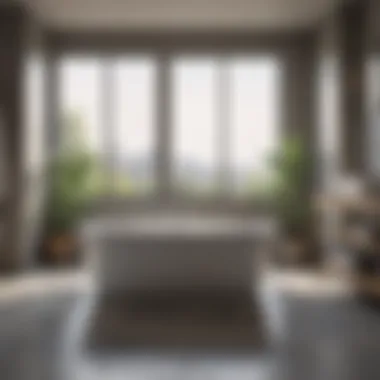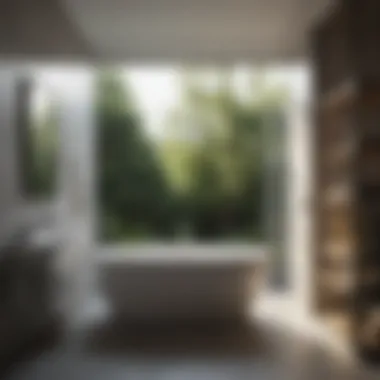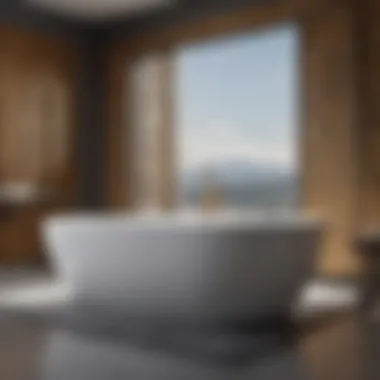Freestanding Bathtub Sizes: A Comprehensive Guide


Intro
The selection of a freestanding bathtub goes beyond aesthetics; it is a decision that intertwines design sensibilities with the pragmatic needs of your space. This comprehensive guide aims to unravel the complexities associated with freestanding bathtub sizes, providing insights into factors that dictate their dimensions. Understanding these elements is pivotal for homeowners, interior design enthusiasts, and individuals seeking to create a personal retreat in their bathrooms.
Freestanding bathtubs vary significantly in size, shape, and style, which influences both usability and the overall design scheme. As you navigate through this article, expect a balanced blend of technical specifications and design inspirations that cater to the modern homeowner. This guide hopes to serve as a critical resource for those who embark on the journey of designing their ideal bathing sanctuary.
Understanding Freestanding Bathtubs
Freestanding bathtubs have gained notable popularity due to their aesthetic appeal and versatility. Understanding these bathtubs is crucial for homeowners and interior designers aiming to create an inviting atmosphere in their bathroom spaces. The right bathtub can enhance not only functionality but also the overall design aesthetic.
Definition and Characteristics
Freestanding bathtubs are standalone units that do not rely on surrounding walls or supports. They allow for more flexibility in placement compared to traditional bathtubs, which are usually installed against a wall. This feature provides homeowners with a variety of layout options. Often, freestanding tubs are designed with ergonomic features that cater to comfort, making them ideal for leisurely baths.
Commonly, these bathtubs are available in diverse shapes and styles, catering to personal preferences and design themes. Whether one opts for a classic clawfoot design or a modern, sleek silhouette, freestanding bathtubs can serve as a focal point in any bathroom. The height, depth, and width can vary significantly, which underscores the importance of selecting a size that fits both the space and user needs.
Common Materials Used
The materials used in the construction of freestanding bathtubs largely influence their durability, maintenance, and aesthetic appearance. Common materials include:
- Acrylic: Known for its lightweight and insulating properties, acrylic bathtubs are easy to install and maintain. They also come in various colors and styles.
- Cast Iron: This material is renowned for durability and retains heat well, making it a comfortable option for long soaks. However, it is quite heavy and may require additional support.
- Fiberglass: As a cost-effective option, fiberglass bathtubs are lightweight and available in numerous designs. Yet, they may not provide the same level of durability as other materials.
- Stone: Bathtubs made from stone materials such as marble or granite have a luxurious appearance. These are generally heavier and often come with a higher price tag.
Choosing the right material is key to achieving the desired aesthetic while ensuring long-term use. Each material offers a unique set of benefits, and understanding these can significantly influence your buying decision.
“The choice of material can affect not just the look of your bath but also its upkeep and comfort.”
In summary, comprehending the various characteristics and common materials of freestanding bathtubs helps homeowners make informed decisions that align with their design aspirations and practical needs.
Standard Freestanding Bathtub Sizes
Understanding the standard sizes of freestanding bathtubs is essential for homeowners. These sizes can greatly impact the overall functionality and aesthetics of a bathroom. Selecting the right size will depend on various factors such as available space, user needs, and preferences. Standard sizes offer a good starting point, providing familiarity while still allowing for flexibility in design.
Small Size Bathtubs
Small freestanding bathtubs usually range from 54 to 60 inches in length. These sizes are perfect for compact spaces where maximizing room is critical. One of the primary advantages of small bathtubs is their versatility. They fit well in smaller bathrooms, powder rooms, or even corner setups, allowing homeowners to enjoy a relaxing bath without requiring extensive space.
Additionally, small bathtubs often come in attractive designs that do not compromise on style. Many people opt for smaller sizes also due to ease of installation. However, it is vital to consider user comfort. A small bathtub may not be suitable for those who prefer a more spacious bathing experience.
Medium Size Bathtubs
Medium-sized freestanding bathtubs typically measure between 60 to 70 inches long. This is one of the most popular categories on the market today. Medium bathtubs offer a balance between space and comfort, which many homeowners find appealing. They can accommodate one or two users comfortably, making them ideal for couples or families.
The flexibility in design is noticeable as well. Many medium-sized bathtubs come in several styles, from modern to traditional, allowing integration into diverse decor themes. When considering these bathtubs, the layout of the bathroom becomes important. Sufficient space for walking and maneuvering around the bathtub is crucial to avoid a cramped feel in the overall design.
Large Size Bathtubs
Large freestanding bathtubs generally measure over 70 inches in length, sometimes extending to 80 inches. These bathtubs provide a luxurious bathing experience, ideal for those who have ample space in their bathrooms. They allow for a more extended soak, offering deep satisfaction for relaxation and enjoyment.
However, with their size comes the need for careful planning and consideration. Installation requires adequate plumbing and drainage systems, which might not be straightforward in older homes. Large bathtubs can also become significant focal points within a bathroom, influencing the overall design and layout. Therefore, homeowners should ensure the scale and proportion align well with other fixtures.
In summation, selecting the right freestanding bathtub size is critical. Small, medium, and large options each carry unique benefits and considerations. Whether focusing on space, comfort, or luxury, understanding these sizes enables a well-informed and satisfying choice for homeowners.
Measuring for Your Space
When considering a freestanding bathtub, measuring for your space is a crucial step that should not be overlooked. Knowing the dimensions of your bathroom is essential to ensure that the tub will fit comfortably. Not only does this affect aesthetics, but it also impacts functionality when it comes to use and maintenance. A well-fitted bathtub enhances the overall bathroom experience, while an ill-fitting one can lead to clutter and inconvenience.


Room Dimensions Consideration
The first step in measuring for your freestanding bathtub is to understand your room dimensions. Take careful measurements of the area where you plan to install the tub. This means accounting for the overall width, length, and height of your space.
- Width: Ensure that there is enough space for the tub itself and additional elements like pathways or walking space.
- Length: Measure the length from walls or other fixtures. This will determine not only the tub size but also how it fits with surrounding elements.
- Height: Consider any ceiling restrictions; a tall tub may look appealing but might not fit comfortably under a low ceiling.
It is also important to measure the distance between fixtures such as sinks, toilets, or cabinetry. This helps in visualizing how the bathtub complements or contrasts with the rest of your bathroom layout.
Access and Placement
Once you have the room dimensions, the next aspect is access and placement. Assess the entry points and layout of your bathroom. Can you smoothly maneuver the bathtub into the desired location? This is especially pertinent for larger models. The path must be clear, free of obstacles like doors and furniture, to avoid damages.
Consider also the proximity to plumbing fixtures. Installing a bathtub far from existing plumbing can lead to complicated and costly renovations. From a design standpoint, strategic placement allows for a more visually appealing setting.
Ensure that the tub is positioned in a way that enhances usability.
Proper measuring and planning can save time, money, and frustration during installation.
In summary, by taking precise measurements and planning the placement of your freestanding bathtub, you create a harmonious balance between form and function. This careful preparation sets the foundation for a successful installation and long-lasting enjoyment of your spa-like oasis at home.
Custom Freestanding Bathtubs
Custom freestanding bathtubs are increasingly popular among homeowners who seek a personalized touch for their bathrooms. Unlike standard models, these tubs offer a myriad of customization options to suit individual preferences. This section explores the significance of custom bathtubs, focusing on their benefits and common sizes.
Benefits of Customization
One of the primary advantages of custom freestanding bathtubs is the ability to tailor the design to match specific dimensions and aesthetic preferences. Homeowners can choose from various shapes, colors, and finishes. This flexibility ensures that the bathtub complements existing décor while fulfilling functional needs.
Another notable benefit is the option to select materials that best suit the environment. For instance, certain materials retain heat better, which enhances comfort during long soaks. Additionally, customization allows for ergonomic considerations, improving user experience and promoting relaxation. This personalization can significantly elevate the overall atmosphere of the bathroom.
Customization also poses an opportunity for homeowners to invest in unique features. For example, some may opt for built-in shelves or lighting integrated into the design. Such elements can elevate the bath experience while adding practical storage solutions.
Popular Custom Sizes
Custom sizes vary widely based on the individual’s space and need. Popular dimensions often include:
- 60 inches: This size is common for smaller bathrooms and offers a cozy soak experience.
- 66 inches: A medium size popular with those who want a bit more stretching room, still fitting well in average spaces.
- 72 inches: A larger option that appeals to homeowners looking for a spacious relaxation area, while still being manageable in many bathrooms.
In addition to these sizes, custom bathtubs can also be designed to fit specific alcoves or unique architectural features of the home. Such adaptations ensure optimal use of space and make the bathtub a focal point of the bathroom design. By taking the time to explore custom options, homeowners can create a space that not only looks good but also enhances the personal bath experience.
"Customization of your bathtub can lead to not only enhanced comfort but also a bathroom tailored to your specific taste."
Overall, custom freestanding bathtubs combine functionality with individual style. This approach allows homeowners to transform a simple bathing area into a luxurious sanctuary.
Design Aesthetics and Sizes
Understanding the design aesthetics of freestanding bathtubs is crucial for creating a harmonious bathroom environment. The way a bathtub fits within the overall design of the space impacts not just functionality but also visual appeal. A well-chosen bathtub can significantly elevate the style of a room, enhancing its character and mood. Homeowners should consider how different sizes and shapes relate to the existing decor and layout.
Impact on Bathroom Design
The influence of bathtub size on bathroom design cannot be overstated. A large tub can become a statement piece, drawing attention and serving as a focal point in the room. In contrast, a smaller bathtub can create an illusion of space, making a bathroom feel more open and accommodating.
Choosing the right size also affects the layout. A compact design allows for more floor space, which can be utilized for storage or additional features, leading to a more functional space. Moreover, designing around the bathtub size may necessitate changes to other fixtures, such as the sink or shower placement, ensuring all components work cohesively. It is important to balance the size of the tub with the overall dimensions of the bathroom. Excessively large tubs in cramped spaces can lead to a cluttered look, while very small tubs can feel insignificant in expansive bathrooms.
Visual Balance with Other Fixtures


Achieving visual balance in a bathroom requires careful consideration of the bathtub in relation to other fixtures. A freestanding bathtub should complement rather than overwhelm. If you have a large soaking tub, it is advisable to pair it with fixtures that share similar proportions. For instance, a more substantial sink can enhance the aesthetics, contributing to uniformity.
Additionally, consider color and material when assessing balance. A white tub can provide a clean contrast against darker fixtures, while a colored or textured bathtub can introduce warmth and depth to the design.
The configuration of the room also plays a significant role. Bathtubs placed in the center can act as a centerpiece. In contrast, those against a wall might appear to recede visually. The alignment of the tub with elements like mirrors, windows, and lighting can significantly affect how the bathroom is perceived. Proper arrangement leads to a serene, well-structured ambiance.
"A well-balanced bathroom promotes both aesthetic appeal and functionality, enhancing the overall user experience."
Selecting the Right Size
Choosing the right size of a freestanding bathtub is crucial. The size affects not only the look of the bathroom but also comfort and functionality. The wrong size can lead to an awkward space that does not serve its purpose well. Homeowners need to consider various factors to make an informed decision.
User Dimensions and Comfort
The comfort of a bathtub largely depends on the dimensions of the user. A taller person may find a shorter bathtub uncomfortable. The width should also allow enough space to move freely. Therefore, it’s important to measure both height and body shape. For instance, homeowners should ask themselves how they plan to use the bathtub. If it is for relaxing, a deeper tub might be better. Likewise, the overall dimensions impact how much water is needed to fill it.
Consider the following factors when evaluating user dimensions:
- Height: Taller users need deeper tubs for better soaking experiences.
- Weight: Heavier users may want wider tubs for better support.
- Mobility: Those with limited mobility may require easier access and stability features in size.
Lifestyle and Usage Patterns
Lifestyle plays a significant role in choosing bathtub size. For example, households with children may prefer smaller tubs for safety. Alternatively, an individual who enjoys long, leisurely soaks could benefit from a larger option. It is also wise to consider how often the bathtub will be used and for what purpose.
Think about the following lifestyle aspects when selecting the bathtub size:
- Frequency of Use: More frequent usage might justify a larger investment.
- Family Size: Larger families may require more substantial bathtubs.
- Personal Preferences: Different users have various preferences for bath time activities.
"The right size can significantly enhance both comfort and functionality in your bathroom."
A thoughtful approach to selecting the right freestanding bathtub size can dramatically affect the enjoyment and efficiency of one’s bathing experience.
Installation Considerations
When deciding on a freestanding bathtub, installation considerations must not be overlooked. Various factors come into play that can significantly influence the overall experience and functionality of your new tub. Inadequate installation planning can lead to complications later, affecting comfort and usability. This section details plumbing and drainage requirements, as well as height and accessibility issues, ensuring you make informed choices.
Plumbing and Drainage Requirements
One of the most crucial aspects of installing a freestanding bathtub is ensuring appropriate plumbing and drainage systems. You must confirm that your chosen location has the proper water supply lines and drain access.
- Drain Placement: The drain pipe should align with the tub’s outlet. Misalignment can lead to potential leaks or plumbing problems, requiring costly repairs.
- Pipe Size: Use pipes that are adequately sized to handle water flow from the tub. Common sizes for drain pipes are 1.5 inches to 2 inches, which need to be verified before installation.
- Water Supply: It's important to ensure that the hot and cold water feeds are within reach. Adequate pressure is also important for both comfort and efficiency.
Proper plumbing installation is key to a hassle-free experience, eliminating future drainage issues and potential water damage.
Height and Accessibility Issues
Another factor affecting installation is the height and accessibility of the bathtub. These considerations can dramatically impact usability, especially for varying demographics such as families with small children or elderly individuals.
- Average Height: The standard height of a freestanding bathtub is around 24 inches to 30 inches. However, there are taller designs available for those who find deeper tubs more comfortable.
- Accessibility Features: Consider grab bars or non-slip finishes to enhance safety. Height should also be evaluated based on personal or family needs.
- Ease of Entry: Ensure the tub is not too high to step into easily. This is particularly significant for those with mobility issues, as they may find it difficult to get in and out of taller models.
Planning for these installation factors will result in a more satisfactory experience with your freestanding tub, making it not only a focal point of the bathroom but also a practical addition to your living space.
Cost Factors Based on Size
Understanding the cost factors related to the size of freestanding bathtubs is crucial for prospective buyers. When homeowners consider a freestanding bathtub, it is not only the aesthetics or functionality that comes into play, but also how the price reflects those dimensions. Sizes of bathtubs vary significantly, and each size category bears its own pricing impacts, which can greatly influence the overall budget for a bathroom remodel. The objective of this section is to highlight the aspects that create cost variations based on tub dimensions, enabling informed decisions for house owners.


Price Range Overview
Freestanding bathtubs are available in a range of sizes, and with size, the prices differ widely. Generally, small bathtubs tend to be the most affordable, starting from 300 to 700 dollars. Medium-sized tubs usually range from 700 to 2,000 dollars, while large varieties can go beyond 2,000 dollars, reaching up to 5,000 dollars or more, depending on brand and features.
The following factors influence the price range of freestanding bathtubs:
- Material: The type of material used, such as acrylic, cast iron, or stone, can significantly affect the price. For example, a cast iron bathtub is often more expensive than an acrylic one.
- Design Complexity: The intricacy of the design can raise the price. Unique shapes or custom finishes usually come at a higher cost.
- Brand Reputation: Well-known brands may price their products higher due to perceived quality and craftsmanship.
- Additional Features: Accessories like integrated lighting, air jets, or massage functions also add to the overall price of a bathtub.
On average, buyers can expect to see that the larger the bathtub, the more expensive it generally is. However, it's important to assess whether the size aligns with the specific needs of the household.
Long-term Investment Analysis
Investing in a freestanding bathtub is often a long-term decision that homeowners must carefully analyze. While the upfront costs can be substantial, the value a well-made bathtub adds to a home cannot be overlooked. First, the durability of higher-end materials, such as stone or cast iron, often results in a longer lifespan, making them economical in the long run.
Moreover, larger bathtubs can offer more functionality and comfort, potentially enhancing everyday use and overall satisfaction.
Consider these points regarding long-term value:
- Increased Home Value: A properly selected freestanding bathtub can enhance property value, making it an attractive feature for future buyers.
- Reduced Maintenance Costs: Higher-quality materials tend to be easier to maintain, protecting against future repair costs.
- Energy Efficiency: Some bathtubs are designed with energy efficiency in mind, potentially leading to savings on water and heating bills.
Trends in Freestanding Bathtub Sizes
Understanding trends in freestanding bathtub sizes offers insights into consumer preferences and market dynamics. The evolution of designs reflects shifting priorities in functionality and aesthetics. In recent years, several key trends have emerged, influencing both small and large bathtub options.
Emerging Popularity of Compact Designs
Compact designs are gaining traction among homeowners. As urban living spaces shrink, the need for efficient use of space becomes pivotal. Compact freestanding bathtubs present a solution, optimizing both comfort and area. These bathtubs tend to be narrower and shorter, fitting seamlessly into smaller bathrooms without sacrificing style.
Benefits of compact designs include:
- Space Efficiency: They can easily fit in tight corners or smaller rooms.
- Ease of Installation: Often lighter and simpler to install.
- Variety: Available in multiple materials and finishes to match various aesthetic preferences.
As more people embrace minimalist lifestyles, compact freestanding tubs become essential design pieces. They cater to both functionality and contemporary style, making them a preferred choice for many.
Luxury and Larger Options
On the other end of the spectrum, there is a rising trend towards luxurious and larger freestanding bathtubs. These bathtubs emphasize indulgence and relaxation, often featuring deep designs that allow for soaking. Homeowners are more inclined to invest in personal comfort, leading to a demand for spacious options.
Some key characteristics of luxury large bathtubs include:
- Deep Soaking Depths: Ideal for long, relaxing baths.
- Stylish Designs: Often made with high-end materials like cast iron or stone.
- Customization Options: Many brands offer bespoke possibilities to meet personal requirements.
The appeal of luxury bathtubs lies in their ability to transform a bathroom into a personal spa. The increased focus on self-care and wellness further enhances the desire for such products.
"As trends evolve, the availability of both compact and luxury options cater to diverse needs, ensuring that every homeowner can find their perfect fit."
These trends reflect broader societal shifts towards optimizing living spaces and enhancing personal well-being. Understanding these dimensions helps greatly when selecting a freestanding bathtub that aligns with current design movements while meeting practical needs.
The End: Finding the Perfect Fit
In the realm of freestanding bathtubs, choosing the right size transcends mere aesthetics; it signifies a commitment to comfort, functionality, and a harmonious relationship with your living space. As explored throughout this guide, the size selection of a freestanding bathtub holds significant implications on multiple fronts. The importance of understanding your space and personal preferences cannot be overstated, as these factors influence not only the visual impact of your bathroom but also user comfort during bathing.
Key Takeaways on Size Selection
When deliberating on freestanding bathtub dimensions, several key takeaways emerge:
- Space Utilization: Measure your bathroom dimensions meticulously to ensure a good fit. Bathtubs should complement, not clutter, the space.
- User Access and Comfort: Consider the height and width of users. Larger bathtubs may look elegant but can hinder accessibility for some individuals.
- Design Harmony: The size of a bathtub plays a critical role in the overall bathroom design. A visually balanced layout can enhance the aesthetic appeal of the room.
- Custom Options: For unique spaces, custom sizes can provide tailored solutions. This investment allows users to maximize both utility and style in their bathtubs.
Final Recommendations
To arrive at a satisfactory decision on freestanding bathtub size, keep the following recommendations in mind:
- Prioritize Practicality: Assess how often the bathtub will be used and by whom. Prioritize practicality over superficial preferences.
- Explore Various Options: Research different sizes available on market. Familiarize yourself with both standard and customized options to widen your choices.
- Consult Professionals: When in doubt, engage with a professional designer or contractor. Their insights can save time and enhance the quality of your selection.
- Revisit Your Needs: Take your time to reflect on your lifestyle and how a bathtub fits into it. Appliances in bathrooms should bring joy and ease, not frustration.



